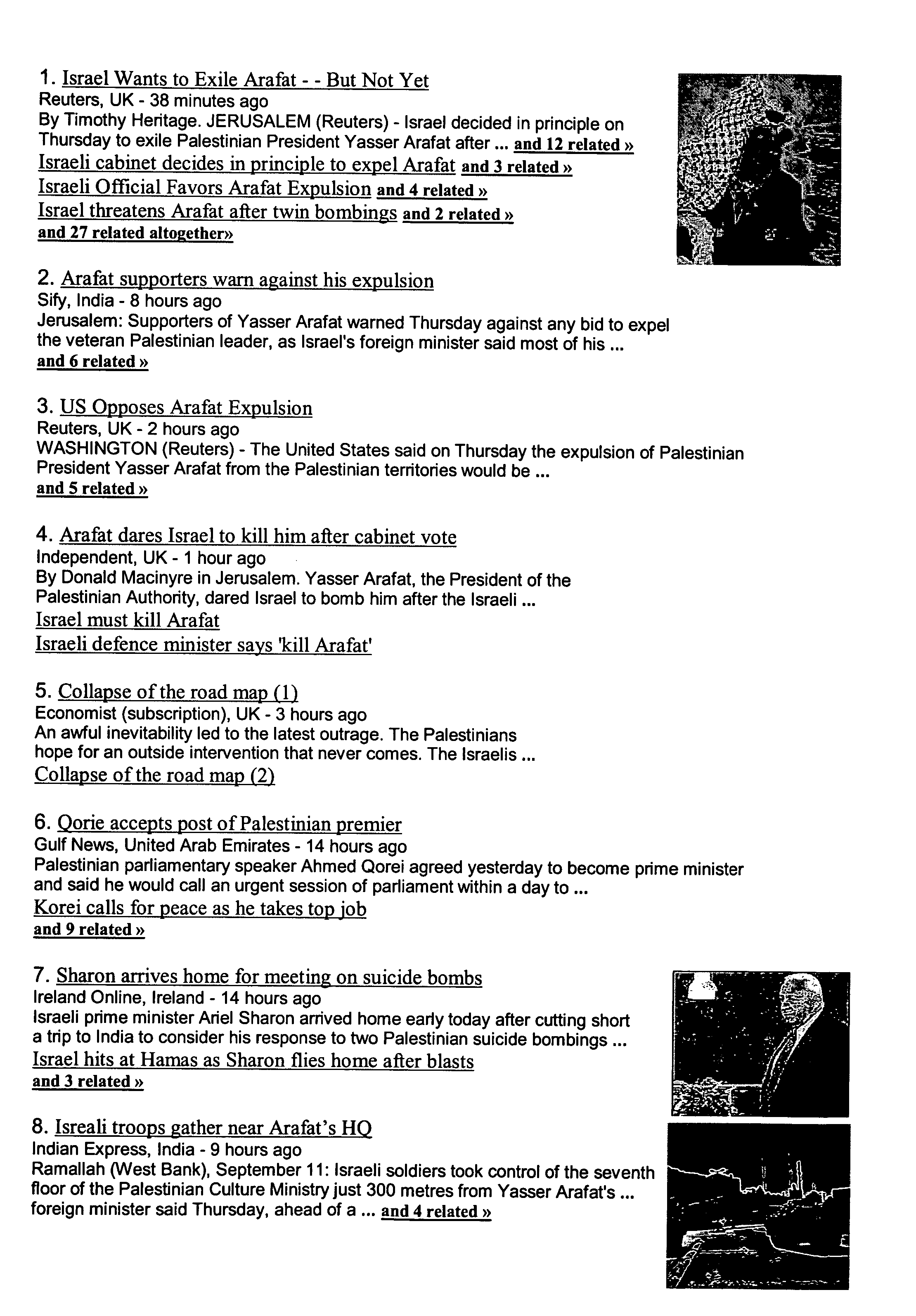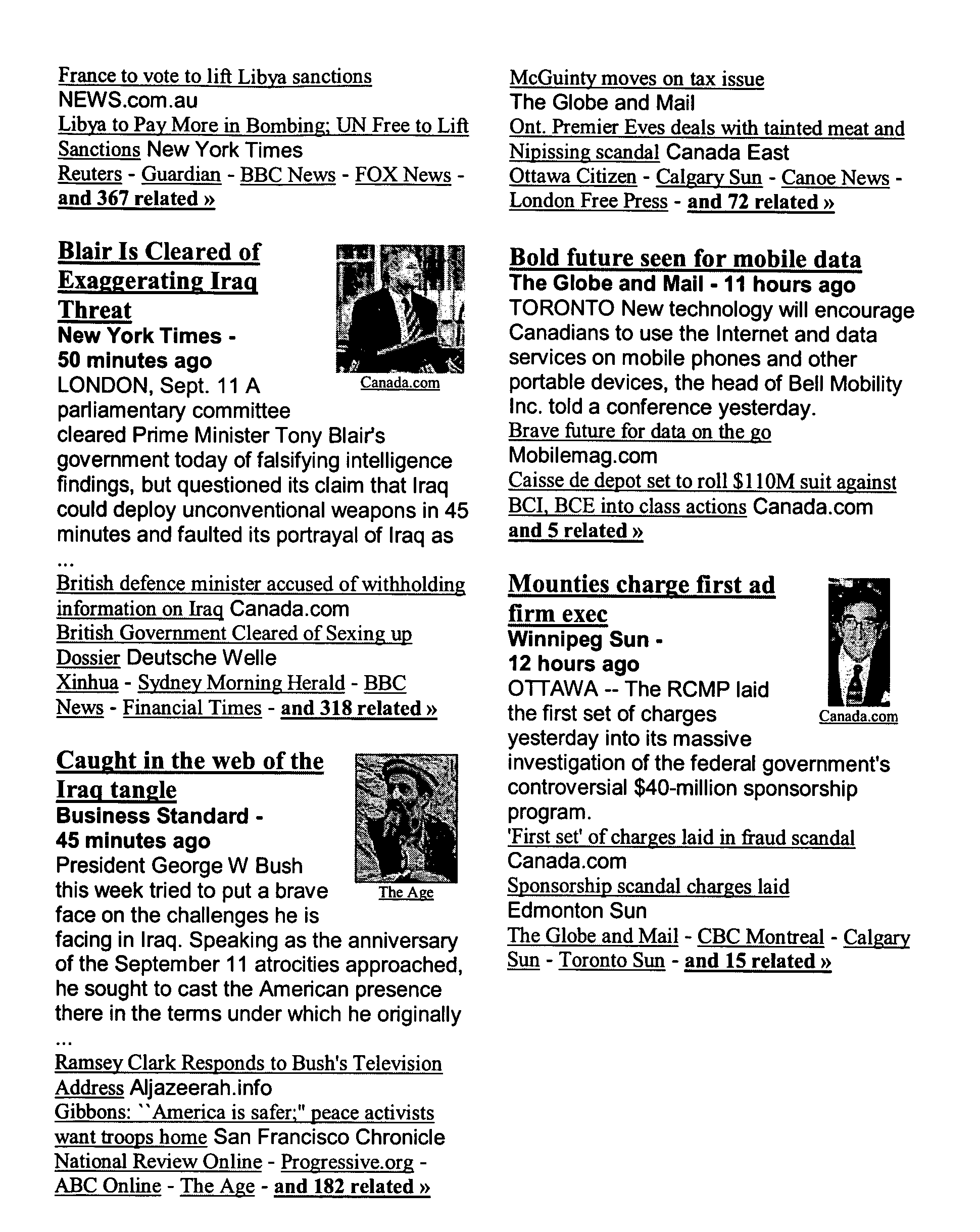[0035] then this might mean for example that the user wants also pages that have words that are synonyms of huge and of bust. However, since the semantic qualifiers don't necessarily have to be only a matter of synonyms, as explained above, another possible variation is that words for which the user wants also synonyms are marked by another mark different from the mark for semantic qualifiers (In other words, the user can mark words for which synonyms are also automatically acceptable, and in this case for example it doesn't matter if the word itself or one of its close synonyms appears on the page, or for example the amount of closeness is also taken into account and preferably the
score is still higher if the word itself appears), and / or the
search engine automatically offers also results with synonyms, especially for example if there are more results for the synonyms, as explained elsewhere in this application. Of course, the above features will be able to work even much better when more structured and / or tagged
semantic information is explicitly included in the pages themselves, such as for example through
XML or
RDF (
Resource Description Framework) or other semantically structured and / or tagged formats, but the
advantage is that the above features can work also reasonably with normal web pages, for example by the methods described above, and thus enable results that can be much more relevant than in normal prior art keyword searches.
[0036] 8. Another possible variation is that preferably the user can also, preferably easily, review also historically the automatically generated items that were on the automatic newspaper (for example in the Science / Tech section or any other section) for example a few hours ago, a few days ago, a few weeks ago, or more. Preferably the user can specify for example the time in hours and / or days to jump back (or for example once the jump size has been defined each next jump is automatically of the same size), or the user specifies for example a specific date and / or time which he / she wishes to view, and / or for example the user can press some link which automatically takes him / her back at each step for example automatically for a
variable time period—determined for example automatically according to the amount of change (for example the amount of change in clusters and / or within them). For this preferably the MetaNews service preferably automatically keeps a history of the links for example with certain time jumps (such as for example
every hour, or any other reasonable
time gap) and / or for example every time a sufficient number of items have changed within clusters and / or clusters have changed, etc. Another possible variation is for example to save in a cache also at least some of the news item pages themselves, but that is of course less efficient.
[0045] (Of course these are just a few examples, and other tag names or structures can also be used). Even such simple tags alone can significantly help search engines to categorize for example pages related to dating sites into sites or pages who's main function is to offer a dating service, sites or pages that are mainly links to other dating sites, sites or pages that mainly review other dating sites, sites or pages that are or contain mainly articles about dating, sites or pages that are or contain mainly fiction stories about dating, etc. Such simple basic tags can for example be generated automatically by smart semantically aware search engines during the generation of the index (so that for example the
search engine preferably uses information from the page itself and preferably also from other pages in the same site and / or pages that link to it and / or pages that are linked to from it, in order to understand in general what the site and / or each page of it is about and generate those tags), and / or for example suggested to the page owner by the automatic conversion
software, or for example such basic tags can also be for example easily manually added by each
web page owner, for example with the incentive that such pages can be more easily cataloged properly by web pages, so that for example a user searching for patent agents will much more easily find the site of a patents agents firm if the page has been tagged properly. Needless to say, adding such few simple tags at the top of each page will be much easier for almost everyone than for example converting
HTML pages to
XML, since experience has shown that even after quite a few years since
XML has been well defined, most web masters still do not like to give up the easiness of
HTML for the complexities and strict structure of XML. If these simple tags become a sufficiently wide-spread new convention, then smart web search engines will be able to even answer queries such as for example:
[0066] c. In addition, Google typically uses also the
anchor text of inbound links to determine the relevance of the linked page to the searched keywords, so that for example if the user is searching for the keywords “free sex”, instead of being fooled by numerous not-really-free pages that use these words extensively to fool search engines to give them a high rank for these popular search keywords, the meaning of this is that Google in fact relies on the fact that if links in other independent sites state in the link itself that this is indeed a free sex page, then probably the human who made the link checked and found out that the linked page is really free, for example. In fact, Google itself did not invent this idea, since in the basic Google U.S. Pat. No. 6,285,999, originally filed in a provisional application on Jan. 10, 1997, and issued on Sep., 4, 2001, Larry Page indicates that this basic idea was already used before by the “
World Wide Web Worm” and by “
Hyperlink Search Engine”, developed by IDD Information Services. On the other hand, this idea is preferably further improved to include at least some semantic analysis of the anchor href text and / or preferably also at least the surrounding nearby text, or at least for example the immediate text preceding the link. This is important since in the above example if for example the text of the link or the text preceding the link says that the following linked page are not really free sex pages or are for example only partially free, and the
system only analyzes the fact that both the word free and the words sex appeared in the
anchor text or near it, then the
system can still be easily mislead. So preferably the analysis of the href text and / or for example the preceding or surrounding near text preferably at least takes into account some
basic language structures such as for example
negation words, or modifying words, such as for example “really”, “partially”, etc., and thus is preferably at least able to identify at least part of the meaning and / or avoid certain pitfalls that are relevant to the interpretation of the real meaning of the link.
[0068] e. Another possible variation is for example to allow the user to define various parameters for scoring the results, preferably on certain allowed ranges, such as for example the
relative weight of usage statistics, the amount of reduction of the importance of a link as a result of the total number of links on the linking page, the amount of taking into consideration the newness of a
web page so that less links to it are required, etc. These values are preferably remembered for example in a browser cookie, and the system preferably displays to the user on each search the parameters that are currently effective. This can give users an additional important flexibility and control, instead of being dependent on sometimes arbitrary decisions by the search engine.
 Login to View More
Login to View More  Login to View More
Login to View More 


